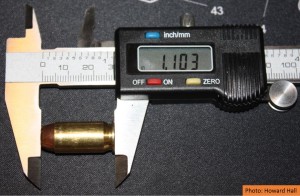
For a number of years, I’d kept a 1911 in .45ACP as my home defense firearm and loaded it with 185 grain jacketed hollow-point cartridges. During this time, I’d followed the advice that I’ve often dispensed to “routinely train with the firearm, firing the personal defense ammunition to ensure 100% reliability and then thoroughly clean the firearm and the magazines."
Well, in the last two years, I switched my home defense firearm to a Sig P227 in .45ACP for the higher capacity (14 versus 8), the integral light rail, and the choice of Double Action or Single Action. Feeling confident with the 185 grain jacketed hollow-point cartridges, I kept the P227 loaded with this ammunition as well. At first, I routinely trained with this handgun/ammunition combination and found it to be as reliable as the 1911 that formerly held this role.
Another Step in the Journey
However, I "fell behind" on training with this system as often as I had in the past… opting to just unload the firearm and the magazines, clean and lubricate both, conduct a non-live-fire function check, re-load, and replace.
 Recently, when I conducted this routine, I noticed how the Sig P227 failed to feed the first cartridge into the chamber which jammed the gun out of battery. Whereas a “tap” to the rear of the slide would normally return to the gun into battery, chamber the cartridge, and lock the slide and barrel to the frame, this cartridge was firmly jammed against the barrel’s feed ramp. For a home defense firearm that must be 100% reliable, I found this to be discomforting.
Recently, when I conducted this routine, I noticed how the Sig P227 failed to feed the first cartridge into the chamber which jammed the gun out of battery. Whereas a “tap” to the rear of the slide would normally return to the gun into battery, chamber the cartridge, and lock the slide and barrel to the frame, this cartridge was firmly jammed against the barrel’s feed ramp. For a home defense firearm that must be 100% reliable, I found this to be discomforting.When I unloaded the gun, the cartridge in question fell free from the magazine and I noticed that it looked “a little different.” Well, it looked a lot different… and so did the second cartridge in the magazine. THEY WERE SHORTER!!!! This different dimension, the overall length, is one of the contributing factors that led to the jam. Other than the obvious concern that these cartridges could potentially jam my firearm when I needed it the most, I wondered how many other cartridges in the magazine were "shorter?"
 With a digital caliper, I measured the overall length (from the end of the cartridge rim to the leading edge of the projectile) of the ammunition from the box which had not been chambered into the Sig P227 and they measured 1.206 inches. This measurement was consistent with all other un-chambered cartridges.
With a digital caliper, I measured the overall length (from the end of the cartridge rim to the leading edge of the projectile) of the ammunition from the box which had not been chambered into the Sig P227 and they measured 1.206 inches. This measurement was consistent with all other un-chambered cartridges.The measurement on the “short” cartridge was 1.103 inches! Although this is only about one-tenth of an inch, it was enough to jam the gun. So, I did a quick test with a “good” cartridge and chambered it repeatedly while taking a measurement between each iteration. I had found that each time I chambered the same cartridge, the bullet “set-back” about five thousands of an inch (0.005?). This could be caused by an insufficient crimp (pressure from the inside of the cartridge case against the outside of the projectile), the edge of the blunt-tipped jacketed hollow-point impacting the feed ramp, or both.
The bullet set-back was not only altering the external geometry of the cartridge as it fed from the magazine into the chamber which increased the potential for a jam, it was also changing the dimensions within the cartridge itself.
Internal Ballistics, Pressure, and Bullet Set-Back
If you recall from the Ballistics Series, there are four components to a metallic cartridge: the case, the primer, the propellant, and the projectile. Ideally, the composition/density of the propellant fills the otherwise empty volume of the cartridge case for a uniform ignition. Continue Reading »
Author: Howard Hall

No comments:
Post a Comment